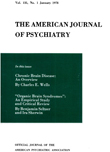THE RELATIONSHIP OF MENTAL AND PHYSICAL STATUS IN INSTITUTIONALIZED AGED PERSONS
Abstract
Our results show that the mental and physical functional status of institutionalized aged persons are highly interrelated. The relationship is seen within each of the 3 types of institutions studied, and for all age groups.
In the different types of institutions it was found that persons tended to have disabilities consistent with the type of services to be expected in the institution. Thus, patients in state hospitals had the largest number with poor mental functional status, while there was predominance of persons with poor physical functional status found in the nursing homes. Nevertheless, institutions of a given type differed widely from each other. Some homes for the aged and nursing homes had a larger proportion of persons with poor mental status than did some state hospitals, while some state hospitals and homes for the aged had more persons with poor physical functional status than did some nursing homes. Therefore, it is possible to make a more accurate prediction of a person's mental status on the basis of his physical status, or of his physical status by his mental status, than on the basis of the type of institution in which he is residing.
Physical functional status is not significantly related to chronologic age in nursing homes or state hospitals. In homes for the aged the relationship is significant, but even then mental status is better than chronologic age in predicting the physical status. A person 85 years of age or over with good mental status is much more likely to have a good physical functional status than a person 74 or younger who is in poor mental condition.
It is concluded that physical and mental aspects of functioning cannot be compartmentalized in aged persons; impairment of either can be regarded as indicating a need for comprehensive medical care. Recent trends in the development of special medical facilities in state hospitals, and both medical and psychiatric services in homes for the aged are apparent recognition of this phenomenon.
Access content
To read the fulltext, please use one of the options below to sign in or purchase access.- Personal login
- Institutional Login
- Sign in via OpenAthens
- Register for access
-
Please login/register if you wish to pair your device and check access availability.
Not a subscriber?
PsychiatryOnline subscription options offer access to the DSM-5 library, books, journals, CME, and patient resources. This all-in-one virtual library provides psychiatrists and mental health professionals with key resources for diagnosis, treatment, research, and professional development.
Need more help? PsychiatryOnline Customer Service may be reached by emailing [email protected] or by calling 800-368-5777 (in the U.S.) or 703-907-7322 (outside the U.S.).



